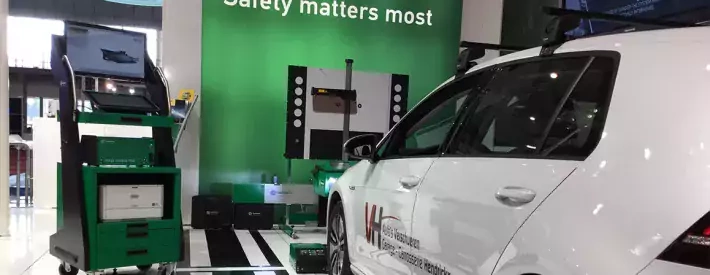Keeping ADAS calibrated

In this article: More vehicles integrate ADAS systems, we take a look at how to keep them calibrated
As perhaps the most pressing issue facing the UK repair industry, the IMI has been working with industry partners to provide guidance on maintaining advanced driver assistance systems (ADAS).
Announcing its new IMI-accredited training course in October 2019, Thatcham Research reported that four million cars on our roads are already fitted with the most popular ADAS function; Autonomous Emergency Braking (AEB). What’s more, every one of the 29 models tested by Euro NCAP that year had at least one ADAS technology.
“The evolution and widespread adoption of ADAS on new vehicles presents the whole repair sector with a challenge,” says Dean Lander, Head of Repair Sector Services at Thatcham. “It’s paramount that repaired vehicles are returned to customers with these potentially life-saving features operating as they were pre-accident.”
A consensus seems to be emerging that every vehicle entering a workshop should be assessed for ADAS. If sensors, or parts close to them, are included in a repair specification then calibration is essential.
Trainer and Head of Hella Gutmann Solutions
Neil Hilton, IMI Automotive Trainer and Head of Hella Gutmann Solutions (HGS), says: “Various bodies are making recommendations but they’re not all singing from the same hymn sheet. In our view the Thatcham position is broadly correct and they should take the lead on this. We also believe that some form of qualification should be required to calibrate these systems.
“If you look at the upcoming EU directive then potentially every new car will soon have 11 ADAS systems. It’s a game-changer. No one is immune to the need for calibration – windscreen replacement, body repair, wheel alignment and many other service and maintenance operations all potentially affect the cameras and radars that these systems rely on.
“Unfortunately, a lot of garages we speak to are still ignorant about this. We run ADAS awareness seminars across the county and it’s a hard message to get out – that every car must be checked. People are shocked by the implications. There have to be avenues for garages that don’t have the kit, whether that’s a friendly garage down the road or a mobile provider. Every workshop has a duty of care to ensure that these sensors are properly calibrated.
“There’s a lot to consider, not least that each VM has its own configuration – some dynamic but the vast majority static. It’s a little like the Betamax and VHS conundrum. We think static is much better because it takes place in a controlled environment, only takes a relatively short amount of time and gives a conclusive result. Dynamic calibration needs to be conducted on the open road and can be affected by factors such as heavy rain. It also takes two technicians out of the garage – one to drive while the other operates the diagnostic equipment. That’s clearly problematic.”
To meet growing demand, HGS recently launched new hardware to extend its Camera and Sensor Calibration (CSC) Tool, including radar cones for Asian vehicles and a solution for Audi’s new rotating beam lidar.
Another notable new product is Bosch’s DAS 3000 – a universal, computer-based calibration device featuring colour-coded retainers to enable the quick and easy mounting of targets at vehicle-specific positions.
Andy Morrison, Technical Manager at Bosch, says: “The number of ADAS-equipped vehicles is soaring and currently much of this work is captured by the dealer networks. However, the opportunity for the aftermarket is significant. Even if a vehicle doesn’t have ADAS, a record should be kept that no calibration was required.”
As a final point, technicians can do all drivers a favour by warning them against over-relying on these exciting new features. In America, the AAA Foundation collaborated with the Virginia Tech Transportation Institute to study distracted driving in ADAS-equipped vehicles. It concluded that, while new users remain alert, experienced users become prone to complacency.




